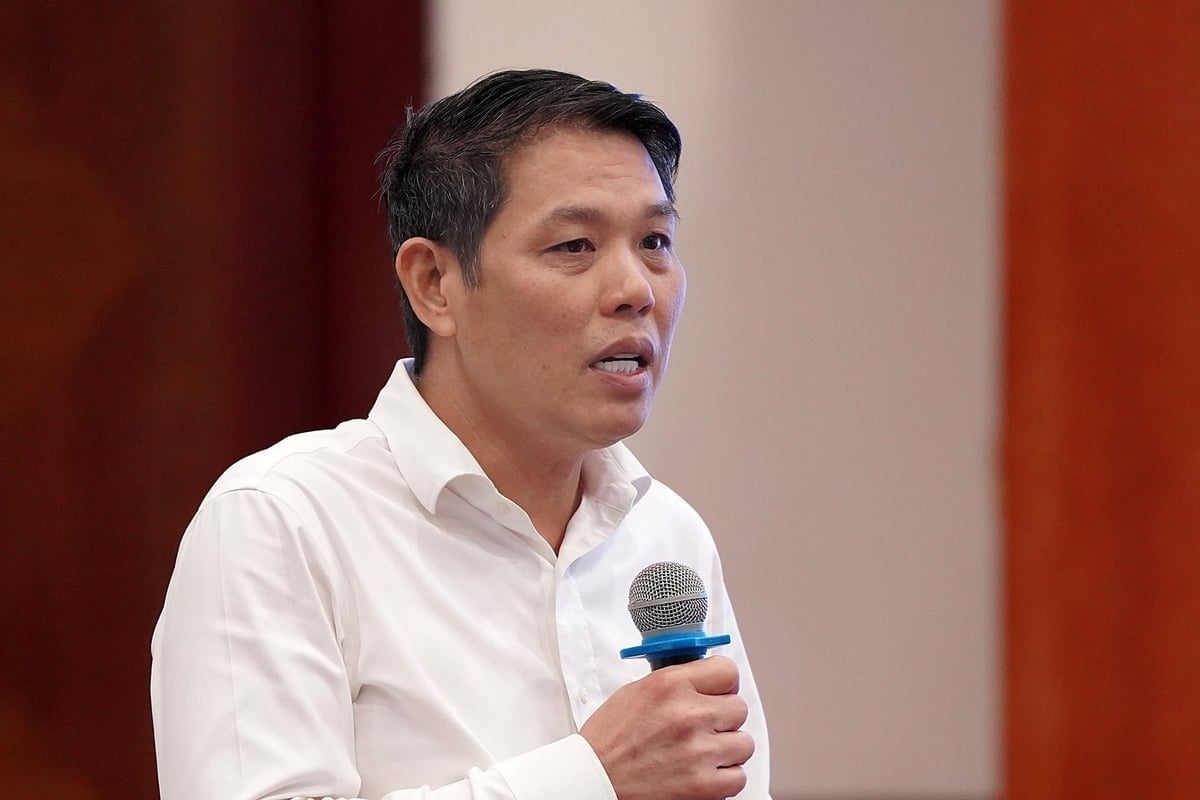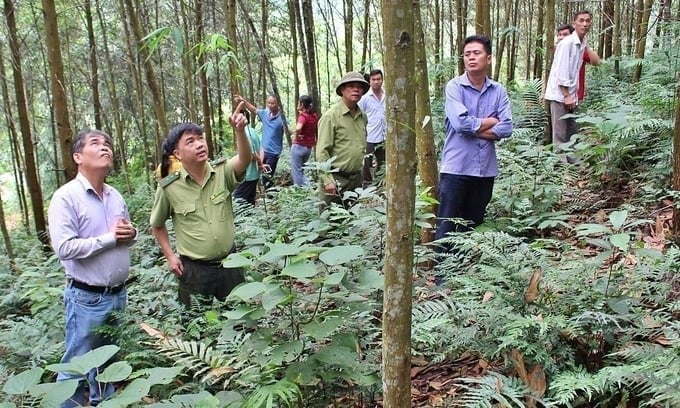November 19, 2025 | 03:23 GMT +7
November 19, 2025 | 03:23 GMT +7
Hotline: 0913.378.918
November 19, 2025 | 03:23 GMT +7
Hotline: 0913.378.918
Vietnam's forests, covering more than 14.8 million hectares with a cover of 42%, have long been likened to the nation's "green lungs." Beyond their values of protection and biodiversity conservation, forests play an important role in absorbing and storing carbon. This is a key task, as Vietnam has committed to achieving net-zero emissions by 2050.
The amount of carbon sequestered in forests is an "asset" that the country can leverage and convert into financial resources for conservation and sustainable development.

Deputy Minister Nguyen Quoc Tri during a working trip at the locality. Photo: The Forestry and Forest Protection Department.
For many years, the international community has always encouraged developing countries to participate in the REDD+ mechanism (Reducing Emissions from Deforestation and Forest Degradation, Conservation, and Enhancement of Forest Carbon Stocks). Vietnam was among the early adopters, establishing a measurement and monitoring system and piloting implementation across various ecological regions.
A breakthrough came with the signing of the Emission Reductions Payment Agreement (ERPA) with the World Bank, through which the North Central region sold 10.3 million carbon credits, earning more than USD 51 million. For the first time, the carbon sequestration value of Vietnam's forests was converted into tangible financial resources, affirming the country's capacity to engage in the global market.
Deputy Minister of Agriculture and Environment Nguyen Quoc Tri assessed that this is only the beginning. "Calculations show that Vietnam could sell about 40 million more credits. At a unit price of USD 5 per credit, we could earn around USD 200 million, equivalent to nearly VND 5 trillion, an amount comparable to the annual public investment capital in many sectors," he underlined.
According to the leader of the Ministry of Agriculture and Environment, to seize this opportunity, Vietnam must quickly build self-reliance in research and assessment and move towards establishing a domestic organization capable of issuing carbon credits in line with international practices, instead of relying on external entities.
To prepare for the carbon market, the Government has issued the National Strategy on Climate Change and developed a draft decree on forest carbon sequestration and storage services. These foundational steps are expected to create a legal basis for the exchange and transfer of credits both domestically and internationally.

Mr. Vu Tan Phuong, Director of the Vietnam Forest Certification Office under the Vietnamese Academy of Forest Sciences, said, "A national standard for forest carbon credits must be developed urgently." Photo: Bao Thang.
However, beyond the policy framework, three critical factors are required to participate in the market, including an internationally standardized Measurement, Reporting, and Verification (MRV) system; an independent and credible credit-issuing organization that is internationally recognized; and an output market with a clear benefit-sharing mechanism to ensure that both forest-protecting communities and forest-planting enterprises gain legitimate income from carbon credits.
According to experts, ERPA currently applies only to natural forests, while Vietnam has a vast area of planted forests, more than 4.7 million hectares, that has not yet been calculated.
Mr. Vu Tan Phuong, Director of the Vietnam Forest Certification Office under the Vietnamese Academy of Forest Sciences, explained, "By 2030, Vietnam will still maintain the closing of natural forests. At that point, supply cannot rely solely on this forest type. Planted forests represent the real potential to expand credit supply."
He stressed that to realize this potential, Vietnam needs to develop a dedicated methodology for planted forests while encouraging forestry enterprises and local people to participate. This would allow planted forests to generate revenue streams from carbon credits, instead of depending solely on timber harvesting, thereby opening up an additional financial channel for sustainable development.
Engaging businesses is considered essential, as the carbon market is not only a story of environmental protection but also a financial market with standards of transparency, auditing, and international transactions. Without the participation of Vietnamese forestry enterprises, the advantage may fall into the hands of foreign organizations.

Survey to collect data for issuing planting area codes in Tuyen Quang province. Photo: Bao Thang.
Meanwhile, with a reasonable benefit-sharing mechanism, forest-dependent communities will gain additional income and become more closely engaged in conservation works, providing strong motivation to reduce pressure on forest land conversion while ensuring the sustainability of the policy.
A clear example of this approach is that Vietnam has begun issuing plantation area codes for raw materials. Since mid-2024, the Vietnamese Academy of Forest Sciences, through its Forestry Economics Research Center, has granted the first certifications for planted forest areas in Tuyen Quang province.
According to Mr. Hoang Lien Son, Director of the Center, the code issuance associated with the iTwood management system not only enhances information transparency and reduces costs across the timber supply chain but also lays the groundwork for digitizing planted forest data nationwide.
This has become a mandatory requirement in the context of international integration, as Vietnam must comply with global regulations such as the VPA/FLEGT and, most recently, the EUDR. Therefore, plantation area codes not only facilitate wood and forest product exports but also serve as a premise for linking planted forests with the carbon credit market and future certification of sustainable forest management.
Practical experience from carbon credit payments in the North Central region shows that revenues from forest environmental service payments and carbon credit sales have been used by some communities to invest in essential infrastructure such as village roads and cultural community houses. This demonstrates that carbon credits not only bring international value but also directly improve local livelihoods.
After more than 80 years of development, Vietnam's forestry sector has come a long way, from a phase focused on timber exploitation as the main source of revenue to forest regeneration and biodiversity conservation, and now to participation in the global carbon market. Step by step, the functions of forests have been expanded, creating a strategic pathway for Vietnam to integrate into the green economy with low emissions and sustainable development.
Translated by Thu Huyen

(VAN) Integrating agricultural extension activities with ecotourism development unlocks promising new avenues for localities boasting specific advantages in grape and apple cultivation.

(VAN) Enterprises and cooperatives accompany farmers in Tay Ninh to develop an organic seedless lime growing area, paving the way for poverty reduction.

(VAN) There were times when Pho faltered, yet his aspiration to bring the pure aroma to those who truly value clean tea kept urging him forward.

(VAN) Bich Thao Coffee Cooperative pioneered products achieving the national 5-star OCOP standard, paving the way for Son La coffee to conquer international markets.

(VAN) The Bao La bamboo-and-rattan cooperative has been producing goods integrated into value chains. As a result, its products have reached global markets.

(VAN) The training course in An Giang equips learners with emission verification methods, thus creating a basis for low-emission rice production.

(VAN) Thu Lum commune is focusing on developing medicinal plants under the forest canopy, creating sustainable livelihoods for local people, and contributing to protecting the ecological environment.